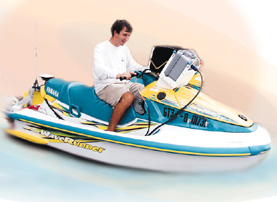Research Shows Rip Currents Can Persist For Months
by Aaron Hover
Rip currents appear to persist for weeks or even months at the same places
along the shore, although they become dangerously strong only under certain
conditions, according to new research by University of Florida coastal engineers.
The findings, which could lead to a better method of predicting when and
where rip currents may occur, conflict with the prevailing view of the currents
as spontaneous and short-lived events.
“We used to believe that the formation of rip currents was relatively
spontaneous and correlated with individual events such as large storms,”
said Bob Dean, a UF professor of civil and coastal engineering. “Now,
we’re starting to believe rip currents persist for longer time periods
at various strengths — sometimes as long as several weeks or months.”
For the study, Dean and Jamie MacMahan, a UF doctoral student in civil and
coastal engineering, analyzed thousands of time-elapsed photos of a rip
current-prone section of the beach on North Carolina’s Outer Banks.
Shot hourly for more than two years from a 100-foot tower at a federal research
facility, the photos revealed dark swaths of the ocean the researchers tied
to rip currents. The swaths expanded or shrank as weather and surf conditions
changed — but remained in the same place along the beach even after
storms.
“We’ve identified some that start in May and last until September,”
MacMahan said.
Rip currents typically occur as water pushed between a sandbar and the beach
rushes seaward through a channel in the bar. Dean and MacMahan’s research
found that these channels persist even as wave action moves the sandbar
toward the beach. Only a particularly large storm or hurricane moves the
channels, the study found.
The study shows that rip currents likely are much more common than had been
thought, becoming noticeable — and dangerous — only when the flow
of water is sufficient to create a strong current. That tends to occur when
storms or particularly strong tides push large amounts of water toward shore,
piling water into the gap between the sandbar and beach, Dean said. A strong
rip current moves at about three feet per second, as fast as an Olympic
swimmer in a 50-meter sprint, MacMahan said.
Dean and MacMahan said the observations conflict with some traditional theories
about rip currents, which hold that the currents form at nodes in an alongshore
propagating wave, which moves parallel to the shore. The new findings suggest
that certain parts of the shoreline may be more prone to rip currents than
others, and that once coastal engineers know more about the ingredients
of a dangerous rip current they may be able to predict when one will occur,
the researchers said.
In Florida, rip currents resulted in an average of 19 deaths annually between
1989 and 1999, more deaths than caused by hurricanes, tornadoes, storms
and lightning combined, according to a study by the National Weather Service’s
East Central Florida Rip Current Program.
With a total of 30 and 29 rip current-related drownings between 1989 and
1999, Dade and Volusia counties, respectively, had the highest rip current
mortality rates. But rip currents caused fatalities in 24 of Florida’s
25 counties with sandy beaches. The peak month for rip current-related drownings
is April, but the second most drownings occur in September and October,
the study found.
The two-year UF study, funded with a $60,000 grant from Florida Sea Grant,
is only half completed. This year, MacMahan plans to use a personal watercraft
equipped with a global positioning system, depth meter and other equipment
to learn more about the size and shape of the sandbar channels, among other
information.
Contrasting the earlier research, based at a U.S. Army Corps of Engineers
field research laboratory in Duck, N.C., this year’s field work is
set for Ormond Beach in Volusia County. There, a video camera attached to
a lifeguard station already is recording photos of rip currents along part
of the beach.